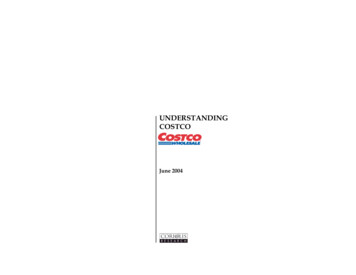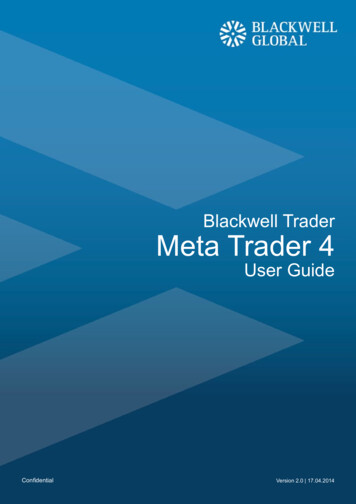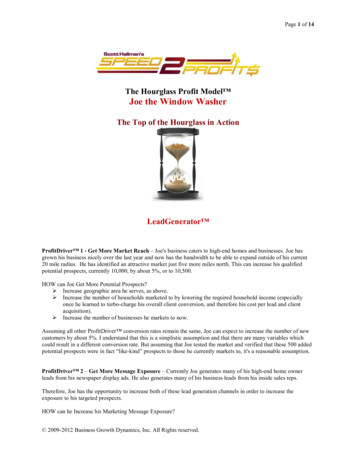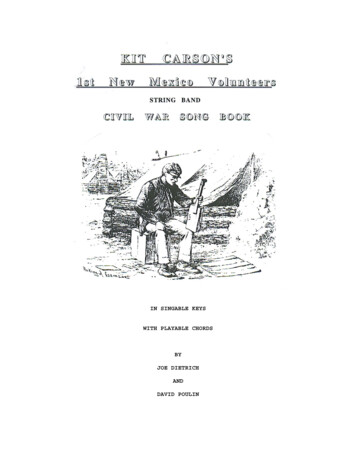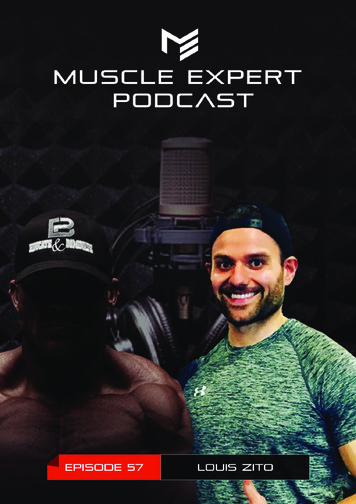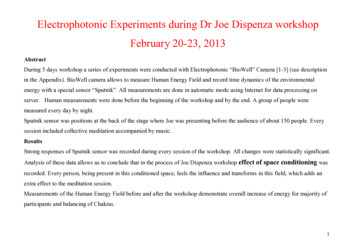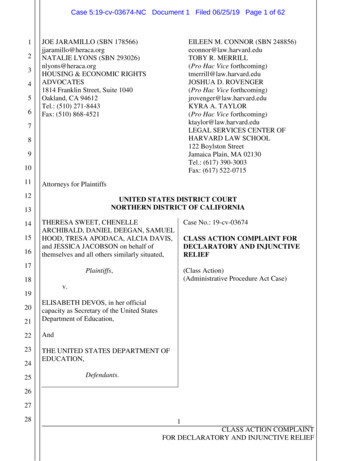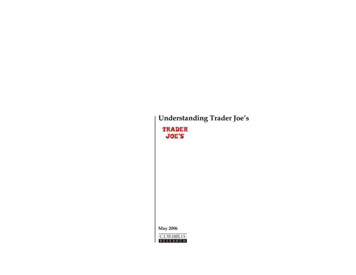
Transcription
Understanding Trader Joe’sMay 2006
Coriolis Research Ltd. is a strategic market research firm founded in 1997 and based in Auckland,New Zealand. Coriolis primarily works with clients in the food and fast moving consumer goodssupply chain, from primary producers to retailers. In addition to working with clients, Coriolisregularly produces reports on current industry topics. Recent reports have included an analysis ofRetail Globalization: Who’s Winning” and “Understanding Costco.” The coriolis force, named for French physicist Gaspard Coriolis (1792-1843), may be seen on a largescale in the movement of winds and ocean currents on the rotating earth. It dominates weatherpatterns, producing the counterclockwise flow observed around low-pressure zones in theNorthern Hemisphere and the clockwise flow around such zones in the Southern Hemisphere. It isthe result of a centripetal force on a mass moving with a velocity radially outward in a rotatingplane. In market research it means understanding the big picture before you get into the details. PO BOX 10 202, Mt. Eden, Auckland 1030, New ZealandTel: 64 9 623 1848; Fax: 64 9 353 1515; email: info@coriolisresearch.comwww.coriolisresearch.com
Understanding Trader Joe’sPROJECT SCOPE & LIMITATIONSThe objective of this document is to give the reader, whether retailer or manufacturer, a deepunderstanding of Trader Joe’s–This overview of Trader Joe’s has a number of key objectives:– Clearly explain the origin and development of this unique concept– Develop an understanding of historic growth and, by implication, future growth potential of the chain– Explore all facets of this complex store concept from multiple points-of-view–The key limitation of this report is the extremely limited amount of publicly available information on Trader Joe’s– Trader Joe’s is a private company owned outright by reclusive German Billionaire Theo Albrecht, who alongwith his brother Karl, founded and still owns the global Aldi supermarket group– Theo bought Trader Joe’s in 1979 from Founder Joe Coulombe. However, Coulombe stayed on under contractfor ten years to manage the business.– As a result, there are no publicly available financial disclosures of any form– We believe this report captures 99% of the information available in the public domain about this fascinatingcompany–We would like to thank Trader Joe’s founder, Joe Coulombe, for giving selflessly of his time in an interview that wasinvaluable to the completion of this project–We are passionate about retailing and retail store formats. This report is part of a series of reports we are developingon stores and store formats that interest us. We welcome your corrections, comments and feedback, as well assuggestions for future topics.Trader Joe's3
Understanding Trader Joe’s“I think we should be traders on the culinary seas.”Joe Coulombe, Founder, Trader Joe’s, 1967Trader Joe's4
Understanding Trader Joe’sDOCUMENT OVERVIEWThis report is divided into three sections: 1. history and development, 2. a concept summary and3. the business modelHistory &DevelopmentConceptSummaryBusinessModelTrader Joe's5
Understanding Trader Joe’sDOCUMENT OVERVIEWThis first section looks at the history and development of Trader Joe’sHistory &DevelopmentTrader Joe's6
Understanding Trader Joe’sSTORE NUMBER GROWTHTrader Joe’s has shown rapid growth in store numbers since the retirement of founder JoeCoulombe, adding 203 stores in 16 yearsNumber of stores(units; actual; 1967-2005)230217205CAGR(88-04)21% 203 3742677449Joe CoulombeSource: various published articles and interviews; various estimates; Coriolis analysis and estimatesJohn 51994199319921991199019671Dan BaneTrader Joe's7
Understanding Trader Joe’sSALES GROWTHTrader Joe’s has shown strong sales growth since 1988, growing at a compound rate of 21% peryear over the periodGroup sales(US ; millions; 1988-2004)CAGR(88-04) 3,000 21% 2,700 2,400 1,900 1,670 1,500 1,200 1,000 500 145 159 200198819891990 2601991 604 710 774 36019921993199419951996Source: various published articles and interviews; various estimates; Coriolis analysis and estimates19971998199920002001200220032004Trader Joe's8
Understanding Trader Joe’sSALES/STORE/WEEK GROWTHTrader Joe’s has grown sales per store per week at a compound rate of 6% per year since 1988Average sales per store per week(US ; actual; 1988-2004)CAGR(88-04) 265,863 6% 265,252 253,283 229,396 235,732 218,531 192,308 184,511 198,939 174,000 173,364 155,087 141,287 119,048 103,276 105,438 103,950198819891990199119921993199419951996Source: various published articles and interviews; various estimates; Coriolis analysis and estimates19971998199920002001200220032004Trader Joe's9
Understanding Trader Joe’sTIMELINEThe history of Trader Joe’s spans over fifty years1952Joseph H. Coulombe graduates from Stanford with a BA in Economics1954Coulombe graduates from Stanford MBA and is hired by Owl Rexall Drug Co.1957Coulombe starts first Pronto Market for Rexall DrugsLate 50’sCoulombe leaves Rexall and works for Hughes1966Coulombe buys six Pronto Markets from Rexall1966Coulombe vacations in St. Barts, French West Indies – Vision of Trader Joe’s realised1967First Trader Joe’s opens in Pasadena; Coulombe begins to convert Pronto units to Trader Joe’s1967First “Insider’s Report” on imported wine started as a photocopied handout1978“Fair Trade” regulations lifted from wine1979Coulombe sells chain to Theo Albrecht and family, owners of Aldi Nord; Joe agrees to remain as CEO for 10 years1979Trader Joe’s launches first Trader Joe’s branded products1983Last Pronto Market closes1987Expands to San Diego1988Coulombe retires as CEO remains as Chairman; John Shields takes over as CEO1989Coulombe finishes 10 year contract to manage chain1989Expands to Northern California1992Expands into Arizona1996Trader Joe’s East created; expands to East Coast; opens first store in Boston2000Expands into Chicago market2002John Shields retires; replaced by Dan Bane2002Launches Charles Shaw “Two Buck Chuck” wineTrader Joe's10
Understanding Trader Joe’sEVOLVING MODELSThe Trader Joe’s concept has evolved over its lifetime from a conventional convenience storeinto an upmarket Aldi-type offerPronto Market1Trader Joe’s(version 1)Trader Joe’s(version 2)Trader Joe’s(version 3)Time ummaryConventionalconvenience storeGourmetconvenience storeGourmet, health& liquor storeDiscount liquor,gourmet and healthstores# of stores1-18Store Size2,400-2,700 sqft4,000-10,000sqft4,000-10,000sqft5,000-12,000 sqft# of sku5,0005,0006,0001,100 (1980’s)2,200-3,300 (current)New CategoriesAdded to MixBread, beverages,snacks and liquorGourmetgroceries, partysuppliesHealth foodsDiscount wines,private labelOwnershipJoe CoulombeJoe CoulombeJoe CoulombeTheo Albrecht(Aldi Nord)Chief ExecutiveJoe CoulombeJoe CoulombeJoe CoulombeJoe Coulombe,John Shields,Dan Bain1. Some Pronto Market stores continued to operate following the founding of Trader Joe’s; Source: various published articles and interviews; Coriolis analysis and estimatesTrader Joe's11
Understanding Trader Joe’sTHE ARRIVAL OF 7-ELEVENJoe Coulombe acquired six Pronto Markets, a chain he had helped to found, just as 7-Eleven wasarriving in California–“The genesis of Trader Joe's began with Pronto Markets, which had a considerable presence in Orange County in the1960s. But when parent company Rexall Drug Co. decided to sell off its retail ventures in 1966, Pronto presidentCoulombe had to decide whether to fight Southland Corp.'s burgeoning 7-Eleven empire for the corner foodstandmarket or to find a new niche in retailing.” Orange County Business Journal, Aug 1990–“When I saw 7-11 stores coming into California in 1967, I started converting the Pronto to Trader Joe's, because I didn'twant to compete with them.” Joe Coulombe, Founder, Trader Joe's, Nov 1986–“The system was born of necessity. Founder Joe Coulombe launched a small convenience-store chain in SouthernCalifornia in 1958 called Pronto Markets. Then came the 1960s and the arrival of the powerful 7-Eleven chain.Coulombe realized that he had to change or get run over.” Workforce Management, Sep 2004–“Something of an enigma, the California-based chain has continually adapted itself to the needs and tastes of itsconsumer base. Trader Joe's was born as a handful of convenience stores, originally known as "Pronto Markets."When 7-Eleven moved in, Coulombe could see that he had to offer something special.” Seattle Times, Jun 1996–“When Coulombe first thought of his idea, he was owner of Pronto convenience -- store franchises in California.Pronto was facing stiff competition from 7-Eleven, which had deeper pockets and could afford better locations.Unfortunately for Coulombe, the adage that 90% of a convenience store's success depends on location was provingtrue.” Investor's Business Daily, Oct 2004Trader Joe's12
Understanding Trader Joe’sTHE TROPICAL VISIONJoe had the vision for Trader Joe’s while sitting on a beach in the French West Indies–“Joe Coulombe lay in a hammock on St. Barts with a tropical drink in his hand. At that moment, he understood whypeople would pay thousands of dollars for that vacation feeling. If they'd pay thousands for that feeling, how wouldthey react if they were offered the same type of atmosphere at home?. Returning to California from vacation,Coulombe began thinking about how he could convert his stores into outlets that resembled tropical trading posts, recreating the vacation experience as a shopping experience.” Investor's Business Daily, Oct 2004–“After a Caribbean sabbatical, and backed by Bank of America financing for a buyout from Rexall, Coulombereturned with a concept of turning Pronto into an upscale market/party store located near educational centers.” OrangeCounty Business Journal, Aug 1990Trader Joe's13
Understanding Trader Joe’sTARGET THE EDUCATED JET-SETJoe identified the well educated, adventurous middle class as his target market–“He decided it was time to make a change. Otherwise, they would have swamped us. So he decided that with theadvent of the 747 jet, people were traveling more, and they had a sense of adventure. They were more willing to trynew things. He also decided to focus on well-educated customers. The higher the level of education, the more likelycustomers are to be particular about the choices they make. And they're less likely to be swayed by network TV ads ormedia blitzes.” Pat St. John, VP Marketing, Trader Joe’s, Jul 1988–“Two social trends struck him: rising levels of sophistication and education, and the boom in overseas travel usheredin by the jumbo jet and discount airfares. These well-educated and well-traveled people were exposed to new foodsand wanted to impress their friends and neighbors with their newly acquired tastes.” Forbes, Oct 1989–“His first step was to identify his market. "What you want is a coherent group of customers, and you shape yourselfaround it," Coulombe said. He began building his customer profile through reading an issue of Scientific American.It reported that the share of adult Americans who'd attended college was up to 60% from 2% in 1932. He foundanother key bit of information in the newspaper: Boeing Corp. would be putting its jumbo 747 jets into service by1970. Coulombe's customer profile was taking shape. He'd target the well-educated, well-traveled customer who wasmore likely to experiment with food and drink. Armed with that information, Coulombe rented a storefront inPasadena. He fixed it up to look like a South Seas trading post, the trademark Trader Joe's look. He tacked fish netsand boat oars on the walls. Ships' hatches doubled as cash register counters. Employees dressed in bright tropicalshirts. He stocked foods he knew were vacation favorites: Mexican salsa, exotic teas and liqueurs, hearty wines andpungent cheeses. He brokered deals with merchants around the world to get a wide variety of items.” Investor's BusinessDaily, Oct 2004Trader Joe's14
Understanding Trader Joe’sFAMILY INFLUENCESJoe also credits family influences for the “overeducated, underpaid” concept–“In 1953 he married Alice Steere, a fellow grad student, whose father was William C. Steere, a Stanford botanyprofessor and later dean of the Graduate Division and later still, president of the New York Botanical Garden. It maybe a bit of an exaggeration, but Coulombe says a full professor in those days earned about as much as a journeymangrocer, so it was from the Steeres and the academic community that he learned about the class of consumers thatwould later provide his customer base. “Part of the idea of appealing to overeducated, underpaid people came frommy mother-in-law, Dorothy Steere. I saw how she managed on that salary to produce excellent food. Bill Steere taughtme to drink cheap wine. For our wedding reception, held at the Steeres’ house on Mayfield Road, we went to RubyHill Winery in Pleasanton and bought gallon jugs of chardonnay for a dollar. Steere also taught a course in economicbotany, which involved visiting small wineries like Mayacamas, which was one of the first boutiques we sold atTrader Joe’s,” Coulombe recalls.” Stanford Business Magazine, February 2006Trader Joe's15
Understanding Trader Joe’sTHE EVOLVING MODELThe Trader Joe’s model evolved through the late 60’s and 70’s–“So he went upscale, swapping soda pop and chips for wine and cheese, and he tried to improve business by talking up hisgoods and encouraging his workers to do the same. The combination clicked and evolved into a business that specialized ingourmet items that Coulombe would find in his travels and stock in his stores, where his workers would cheerfully tout theproducts to customers.” Workforce Management, Sep 2004–“Since the liquor industry was then artif
Understanding Trader Joe’s Trader Joe's PROJECT SCOPE & LIMITATIONS The objective of this document is to give the reader, whether retailer or manufacturer, a deep
